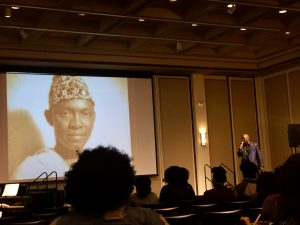
During black history month, I attended an event called Langston Hughes Ask Your Mama: Twelve Moods for Jazz. I went to this event on the evening of February 19th and enjoyed the poems and jazz music performed and the food provided. This program was presented in the form of a concert, where Roy McCurdy performed the Twelve Mood for Jazz with the poems of Langston Hughes mixed with the vibrant jazz music. This program was a multimedia concert that not only contained jazz music, but also included a backdrop with informational content including pictures and videos. Each mood/section of this event shared a story incorporating detailed events of African American history. This program was just as informational as it was entertaining. Being a member of the audience gave me the chance to learn more about African American history including important figures who played large roles in shaping African American culture. Langston Hughes was an important figure who worked to gain freedom for all African Americans and put an end to segregation. This event gave the audience a look into the lives of African Americans in the late 1950’s and early 1960’s.
There were many moments that stood out to me during this event. Somethings were repeated several times throughout the program, to emphasize the importance. McCurdy repeated, “In the quarter of the negroes” throughout the program expressing one of the main themes of segregation. “In the quarter of the negroes” refers to a neighborhood or area where only black people live that is separated from the white majority. This is constantly repeated because it signifies the exclusion that African Americans faced that forced them to live apart in what was known as “ghetto” areas. In mood one, the Culture Exchange, Hughes talked about dreams they had where things were different and roles were reversed; “Wealthy negroes have white servants, white sharecroppers work the black plantations, and colored children have white mammies.” While McCurdy was performing he did a great job at mirroring the expressions black people felt during the 1960’s as they dreamed of better lives while still passing on wisdom and smiles to their children.
In class we read the book Barracoon where Zora Neale Hurston wrote about the hardships that Cudjo Lewis had to endure as he was the last known survivor of the transatlantic slave trade. I found many connections between the Langston Hughes project and this book. During the times when Hurston was an influential writer to the African American community, Langston Hughes was also an influential figure to the community. They were able to shed light on the struggles of African Americans and helping them come together in celebration. In both the book and poems we see the importance that children play in African American history as they helped uplift the parents as they worked on plantations and further worked through life with little money and poor conditions.
As an audience member of this event, I felt as though I learned a lot while still able to enjoy a relaxed concert vibe. The jazz music is not only a very integral part of African American history, but also a lovely way to include the audience and make it more interesting to listen to. The way that McCurdy recited his lines with conviction and put emphasis on certain words gave the audience a little taste of the hardships as well as triumphs of growing up as an African American in the 1960’s. People of color were often treated with disrespect and dehumanized in the eyes of the white population who took control of their rights and lives.
Each of the Twelve Moods for Jazz represent a different theme of the event and in history. Themes such as suffering, culture, unity, freedom and many more were presented during the Langston Hughes Ask Your Mama: Twelve Moods for Jazz program. During this event we could see the strong theme of unity. Through this event we see the aftermath of slavery and still see constant mistreatment and disregarding of African Americans. African Americans were treated poorly because of the color of their skin, although they had to suffer through slavery and recurring biases, African Americans found a way to unite to form a strong culture through dance, jazz music and rituals that united them to make them stronger to fight their battles.

